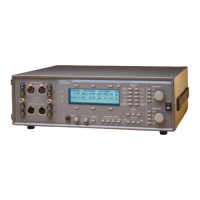Isolating Sources of THD+N
Because the THD+N reading may contain several different types of unwanted sounds,
it may sometimes be helpful to be able to isolate which types of sounds are contributing
to the measurement.
First, check your device to make certain that the amplitudes are correct and that there
are no other sound sources making contributions to the output. Many THD+N
problems are the result of this sort of error.
Then limit the low-frequencies using the 400 Hz highpass filter. This filter will eliminate
the hum, which is usually at 50 Hz or 60 Hz and multiples of this frequency. If you see a
significant difference in the THD+N reading when you engage the 400 Hz filter, then a
significant amount of hum is contributing to the reading.
Next, change the reading units to volts (or any other unit besides % or dB). This will
reconfigure the instrument to read only the filtered amplitude. Check the THD+N
reading and then turn off the generator. If the reading changes significantly, then a
significant amount of distortion is contributing to the reading.
If you have run the two previous tests, and found that the dominant source of unwanted
sound is neither hum nor distortion, it must be either random noise or interference. To
distinguish between these two, run a spectrum-analysis sweep. To do this, change to the
AMPL measurement function and choose the SELECTIVE filter using the bottom left
soft key. Make sure the analyzer is observing the input signal and turn off the
fundamental tone. Then press SWEEP to pull up the sweep panel, set the upper and
lower frequency limits (preferably to same limits as the bandwidth of your THD+N
measurement), and run the sweep. You may need to adjust the upper and lower graph
limits as well.
Choose the largest number of points available (150) and run the sweep. This sweep will
tune the bandpass filter to each frequency and measure the amplitude of signal at that
frequency. While the bandpass filter is too wide for extremely precise results, it may still
reveal the source of the unwanted sound. Wherever there is a significant interference
source (including hum), you will see a peak in the graph. If the signal is dominated by
random noise, it will be essentially smooth. It may slope gently in one direction or the
other, usually upward with increasing frequency.
4 Functions
THD+N (Total Harmonic Distortion plus Noise) Function Descriptions
4-20 ATS-1 Dual Domain User's Manual

